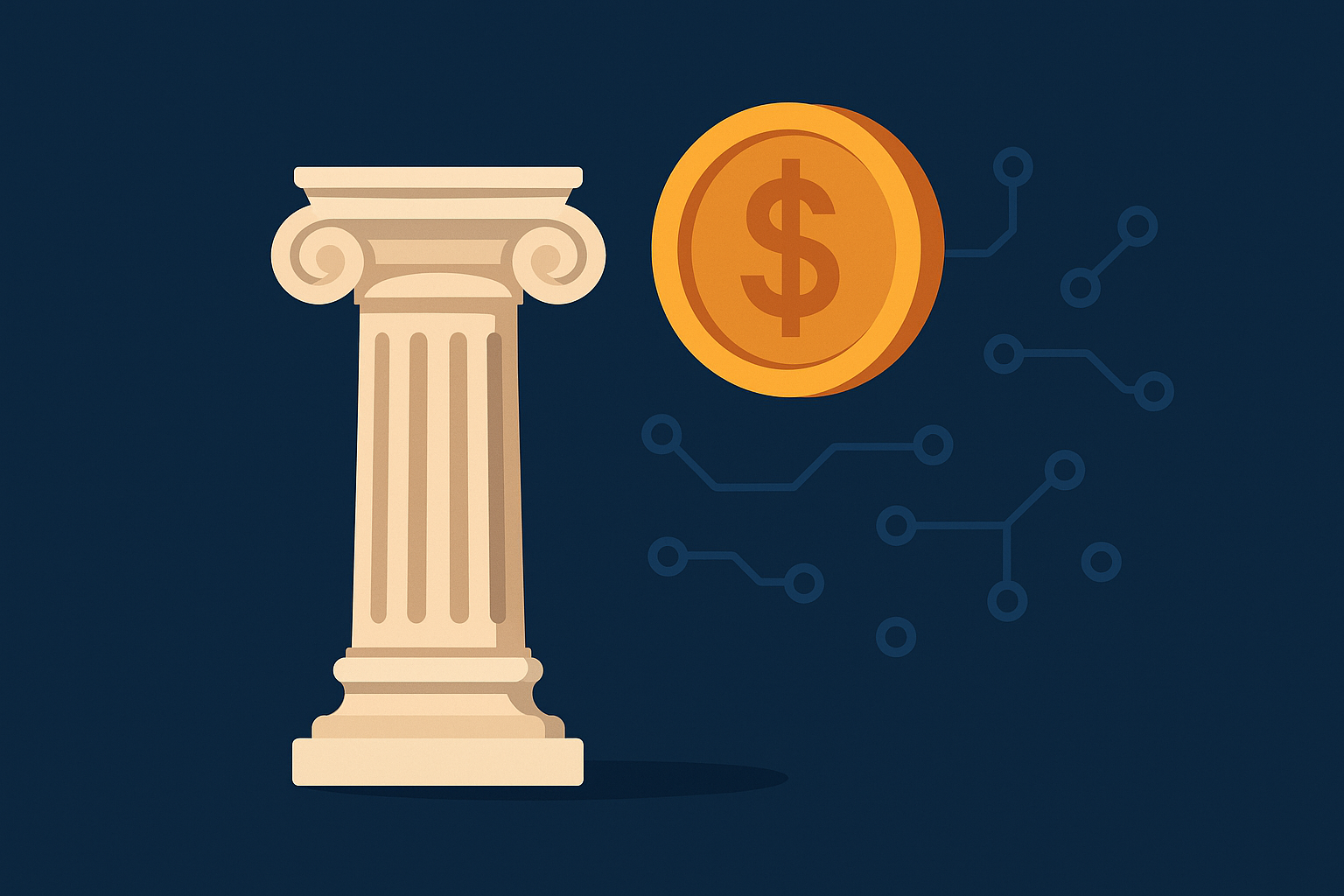By Mr. Young, Chairman of the Federal Money Services Business Association (FedMSB)
—
As the GENIUS Act cleared the U.S. Senate, establishing a federal regulatory framework for stablecoins, many market commentators hailed it as a pivotal moment signaling the mainstream acceptance of crypto finance. Yet from the historical perspective of monetary systems, stablecoins do not represent genuine financial innovation. Rather, they mark a digital inheritance of classical institutional logic. Under the dual momentum of legal endorsement and market convergence, stablecoins are undergoing a process not of institutional disruption, but of institutional transplantation.
The GENIUS Act—short for Stablecoin Compliance and Uniform Innovation Standards Act—creates a dedicated classification for stablecoins as “payment digital assets,” explicitly excluding them from securities and commodities frameworks. Its regulatory logic aligns more closely with that of banking operations. This institutional design reflects the historical prototype of stablecoins: at their core, they are a reconstruction of anchored monetary systems in a new technological context.
I. The Institutional Prototype of Stablecoins: A Digital Reflection of the Gold Standard and Currency Boards
Stablecoins such as USDC and USDT are built upon an “asset-backed and redeemable” mechanism. This concept was well established under the gold standard. In the 19th century, national currencies were issued against gold reserves, with fixed convertibility ratios. Central banks’ gold reserves provided hard backing for paper currencies, granting price stability a solid institutional basis.
In the latter half of the 20th century, especially in emerging economies, currency board arrangements were key to maintaining monetary stability. For instance:
- Hong Kong’s Linked Exchange Rate System (since 1983): HKD is pegged to the USD within a band of 7.75–7.85, with the Hong Kong Monetary Authority adjusting the monetary base automatically based on foreign exchange reserves;
- Early currency boards in Estonia and Bulgaria: Local currencies were fully backed by Deutsche Marks, with transparent and rule-bound issuance mechanisms.
These institutional arrangements mirror today’s stablecoin mechanics:
- 1. Reserves backing issuance;
- 2. Clear redemption pathways;
- 3. Anchor-based value frameworks to build expectations;
- 4. Non-sovereign issuers acting only as rule-following intermediaries.
What’s often termed “decentralized stablecoins” are in essence the migration of these arrangements into smart contracts and distributed ledgers.
II. The GENIUS Act and the Re-legitimization of the “Digital Currency Board” Model
The language of the GENIUS Act deliberately avoids classifying stablecoins under existing securities or commodities law. Instead, it creates a distinct regulatory channel that specifies:
- All issuers must register and meet capital, reserve, and transparency requirements;
- All stablecoins must be 100% backed by U.S. dollars or equivalent liquid assets;
- AML/KYC compliance shall follow banking standards;
- Oversight is led by the U.S. Treasury and the Federal Reserve.
This architecture effectively establishes a “digital currency board” model. Its functional orientation departs from the speculative ethos of early crypto assets, turning instead toward integration with sovereign monetary systems and real-world payment applications.
Rather than a regulatory innovation, the GENIUS Act constitutes a continuity of institutional paradigms. Its passage gives the United States a first-mover legitimacy in global stablecoin governance and signals that stablecoins, as extensions of the U.S. dollar, are now formally recognized within the regulatory mainstream.
III. The Realism of Stablecoins in the Evolution of Monetary Institutions
True monetary innovation requires a reconfiguration of value consensus, issuance mechanisms, and sovereignty structures. Bitcoin, for instance, is considered revolutionary precisely because it circumvents state credit by anchoring trust in algorithmic consensus and fixed supply.
In contrast, stablecoins were designed from the outset within the boundaries of fiat monetary logic:
- Their pegs are to sovereign currencies like the USD or EUR, leaving the credit foundation unchanged;
- Their issuance and redemption depend on centralized institutions and the legacy banking infrastructure;
- Their primary function lies in settlement layers—they do not independently fulfill all three monetary functions (unit of account, store of value, medium of exchange).
Stablecoins are not substitutes for money; they are service layers for existing monetary systems. They improve efficiency but do not alter fundamentals.
The GENIUS Act reflects the United States’ intent to channel stablecoins into institutional frameworks, thereby reinforcing the dollar’s digital reach. This is less about regulating crypto than about building a new global settlement architecture around the U.S. dollar.
Conclusion:
Stablecoins Are a Simulated Institutional Experiment, Not a Paradigm Shift
Throughout monetary history, the most resilient and systemically influential currency regimes have all been rooted in strong rules, strong credit foundations, and coordinated structures. Stablecoins have gained rapid market traction precisely because their institutional DNA is familiar—they are re-enactments of legacy rules dressed in digital form.
The GENIUS Act’s implementation does not mark the triumph of crypto over traditional finance, but rather the successful domestication of crypto by traditional financial logic. The global evolution of stablecoins will continue along the axes of sovereign credit, market rules, and technological neutrality—rather than toward a future of anchorless monetary autonomy.
Payment stablecoins are not innovation; they are the blockchain’s continuation of institutional memory.
—End—
